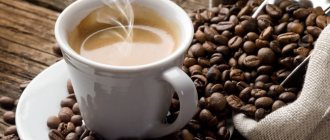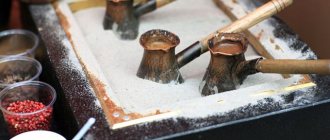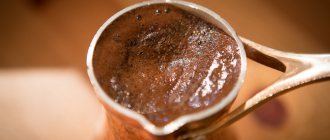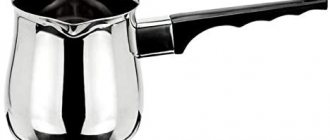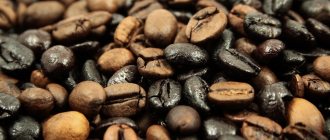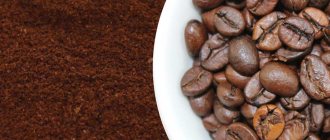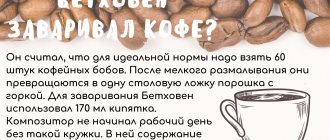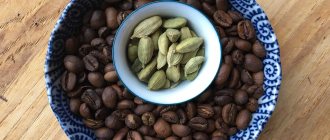How to choose coffee beans?
The taste of coffee depends not only on the variety, but also on the method of processing the beans. The degree of roasting of the beans plays a big role in the final taste:
- Easy. When lightly roasted, the finished coffee has a sour taste. These beans contain the highest amount of caffeine.
- Average. This option is ideal for cooking at home. As a result, the drink turns out aromatic and strong.
- Strong. Coffee made from heavily roasted beans will be appreciated by lovers of a bitter and strong drink.
- Very strong. If you prefer a tart and rich taste, you can choose this option, but it is worth considering that with this method of roasting the grains lose their beneficial properties.
You can assess the degree of roasting by the color of the beans: from light brown for light to black for very strong.
It is important to pay attention to the packaging. When exposed to air, coffee loses its original taste, so the beans must be reliably protected. For the same reason, it is not recommended to buy large packs in order to be able to enjoy a fresh and tasty drink every day.
The most complete guide to types of coffee: from variety and roasting to recipes
Do you order a standard cappuccino so as not to waste time and not have to sort through the endless coffee list? Do you buy “just grains” and are constantly upset that you still don’t get the desired taste? Do you think that coffee only comes in beans, ground and instant? Experts will help you understand the classification of coffee and how to prepare it. After reading this article, you will definitely find coffee that you like and learn how to prepare it correctly.
Where does the coffee bean come from?
Let's start from the beginning. In nature, there are more than 90 species of plants of the genus Coffea, but four species are specially grown, and only two of them are used on an industrial scale.
Arabica
The most popular type of coffee with many man-made varieties. Arabica is a coffee classic with a rich, interesting taste, natural sourness and sweetness. However, Arabica itself is not very rich in caffeine (1-2% of the total chemical composition), so it is often mixed with Robusta.
The name "Arabica" has a geographical origin - people began to grow this type of coffee on the Arabian Peninsula in the 14th century.
Robusta
Not as good in taste as Arabica and has a characteristic bitterness. But Robusta is very tonic: it has 2 times more caffeine than its famous sister. This type of coffee is also good for its endurance: where delicate Arabica dies from temperature changes and diseases, Robusta easily bears fruit. In general, if you are looking for a truly strong coffee, then either pure Robusta or a mixture of Arabica and Robusta, with at least 30% Arabica and Robusta content, will suit you.
Liberica
Many people have heard about Liberica, but few have seen it, although in the coffee world it is considered potentially very interesting. The main advantage of Liberica is its amazing aroma, for which it is grown: essences from Liberian coffee are loved by the confectionery industry. But, for example, in Malaysia, it is more popular than Arabica and Robusta combined.
Excelsa
An even rarer coffee tree, grown in Africa and Southeast Asia. They both love and dislike it at the same time for its fruity and slightly “perfumy” taste with sourness. It is almost impossible to find Excelsa in its pure form in stores, but it is sometimes found in mixtures with Arabica.
Popular coffee varieties
There are about a thousand cultivated varieties of coffee, but they are all subspecies of Arabica and Robusta, or their hybrids. The most common are several subspecies of Arabica, which, when grown in different conditions, often give completely different tastes.
Coffee beans LavAzza “Qualita Oro”, 500 g 752 rub.
Lavazza “Qualita Oro” coffee beans, 250 g 351 rub.
Compagnia Dell'arabica "Jamaica Blue Mountain" bean coffee, 1500 g 48,960 rub.
Coffee beans Paretto “Celesto”, freshly roasted, 1000 g 1619 rub.
Coffee beans Jockey “Traditional”, 100 g 71 rub.
Bean coffee Bushido “Red Katana”, 1000 g 1921 rub.
Coffee beans Lavazza “Qualita Oro”, 1000 g 1550 rub.
Coffee beans Lavazza “Gran Crema Espresso Barista”, 1000 g 1400 rub.
Coffee beans Black card, 1000 g 765 rub.
Coffee beans Lebo “Original”, 100 g 79 rub.
View all coffee beans
- Typika
It is a difficult and fastidious variety of coffee to cultivate, but with proper care it gives the best results. Among the Arabica Typica varieties are the “elite” of the coffee world: Jamaica Blue Mountain, Guatemala, Pluma Hidalgo, Sumatra, Kent, Java, etc.
The main feature of typika: natural sweetness and lack of bitterness.
- Bourbon
A natural mutation of Typica with a rich fruity flavor and complex acidity. The most famous varieties of bourbon: Ibairi, Jackson, Arusha, Yellow, Red, Orange, Pink Bourbons.
- Mocha
One of the most ancient types of Arabica, not bred by man, but formed thanks to nature. Mocha has small beans that, when roasted, produce a rich flavor with spicy notes and a slight heat.
- Maragogyp
Maragogype originated from the usual typica. The main difference of this variety is the huge grains, which are almost 3.5 times larger in size than Typica grains. Maragojipe always has a slight chocolate note in its taste.
Single-origin and blended coffees
All coffee presented in stores is divided into single varieties and blends. The advantage of single varieties is that you can feel the peculiar taste of each individual variety and select your favorite one. The advantage of blending is to harmoniously emphasize the positive properties of each component of the blend and create a product of stable quality.
Types of coffee by processing method
Despite the fact that the final buyer may find out the method of processing coffee cherries in quite rare cases, the processing greatly affects the final taste of the drink.
Dry (natural)
processing is more often used to reduce the cost of the process. With it, the berries are simply dried in the sun on a concrete or brick surface until they turn into something like raisins. After this, the outer layers are peeled off and the grain is sold. Correctly carried out processing gives the taste of coffee sweet shades of berries and fruits. Wrong – earthy taste.
Washed
processing means that the grains are removed from the berries using special equipment, but are not cleared of the sticky shell. In this form, they are placed in fermentation tanks for 1-2 days, and then washed with clean water and dried. Almost all specialty coffee is processed this way.
Honey (semi-washed processing)
– the result of technologists’ experiments. The process works differently in different countries. The difference with washed one is that less water is spent on processing. The finished drink has more sweetness in its taste.
Types of coffee by roasting method
The taste of finished coffee is a combination of natural data (variety and growing conditions) and roasting.
There are quite a few varieties of coffee according to the roasting method. In different sources you can find French, Italian, American, Viennese, but by and large, all types of roasting can be divided into 3 categories.
- Light
Light roasting is called roasting until the first crack (cod). These grains are light brown in color and there are no traces of oils on their surface. Light roasting is good because it most carefully preserves the natural taste of the grain with fruity notes and sourness. True, there is also a minus: if the grain is not initially the best, such roasting will highlight all the shortcomings. Best for alternatives: Chemex, pour over, French press.
Types of light roasts: cinnamon, light, New England, etc.
- Average
Universal roasting at temperatures from 210 to 225 degrees. The beans are chocolate colored, still free of oil stains on the surface. Medium roast is ideal for lovers of the classic taste of coffee. These grains can be prepared in any way.
Types of medium roast: American, city, full city, etc.
- Dark
Roasting at a temperature of 230 to 250 degrees. It is good because it hides the shortcomings of the original grain. It is bad because it does not allow the natural taste of coffee to reveal itself and is, by and large, only suitable for espresso.
Types of dark roast: French, Italian, Spanish.
Types of coffee by grinding degree
Different grinds are suitable for different methods of preparing coffee. The basic rule: the finer the fraction, the faster the coffee extraction will occur.
Ground coffee Lavazza “Crema e Gusto”, 250 g 258 rub.
Ground coffee Lavazza “Qualita Oro”, in a tin can, 250 g 400 rub.
Ground coffee Coffesso “Classico Italiano”, 5 sachets -25%
110 rub. 146 rub.
Ground coffee Jardin “Espresso di Milano”, 250 g 221 rub.
Ground coffee Lebo “Extra”, for Turkish, 75 g 61 rub.
Ground coffee Living Coffee “Espresso”, 200 g 172 rub.
Ground coffee Jockey “Eastern style”, 450 g 334 rub.
Ground coffee Fresco Arabica Barista, for brewing in a cup, 100 g -50%
90 rub. 179 rub.
Ground coffee Jockey “For Turki”, 100 g 66 rub.
Ground coffee Aroma “Arabica for Turks”, 100 g 65 rub.
View all ground coffee
The finest grinding “to dust” is for a cup into which hot water has been poured.
For the cezve, fine grinding is also used, but the feel is similar to particles of sea sand.
Medium grind is used for geyser coffee makers and coffee machines.
Coarse grind – for French press.
Coffee Brewing Methods
Actually, all methods of brewing coffee are divided into 2 main types: preparation in a coffee machine (espresso and all its derivatives) and alternative. Let's talk about them in more detail.
Espresso and its derivatives
Since the invention of the first coffee machine and the creation of the espresso recipe, the coffee world has changed. Engineer Luigi Bezzera, who invented the espresso machine in 1901, had no idea that a century later his brainchild would live in every coffee shop in the world.
Espresso
- a drink that is obtained by passing hot water through a filter with ground coffee under high pressure. In the classic recipe for 30 ml. water required 7 g of coffee. The resulting strong, aromatic and dense coffee can be used as a base for other recipes.
Americano
– espresso, to which 90 ml is added. hot water.
We wrote more about the rules for preparing Americano here>>
Lungo
- also a type of espresso. But at the same time, more water passes through a standard “tablet” with ground coffee. The extraction process also takes longer, so the coffee comes out with a slight bitterness.
Ristretto
- a type of thick and rich espresso, in which 15-20 ml are used for a standard 7 g of coffee. water.
Cappuccino
– espresso, with the addition of milk, whipped into a smooth, beautiful foam. In this case, milk whipped by a cappuccino maker is added to coffee. If you don't have a cappuccino maker at home, you can froth milk using a regular French press.
See how to do it correctly:
Latte
- espresso with milk. In this case, unlike cappuccino, coffee is added to the milk.
Raf
- coffee, invented in Moscow and received its name in honor of a client of one of the capital's coffee shops - Raphael. In addition to the same espresso, it contains liquid cream and sugar (often replaced with syrups). Video recipe for lavender raffa with coconut milk.
Read the history of the appearance of raf here>>
And be sure to try this lavender raf with coconut milk from our tester Natalia Prokhorenko
Macchiato
- espresso with milk, and the milk is not poured in, but put in with a spoon to form a circle with a coffee rim.
Affogato and glasse
– espresso with ice cream. In the first case, a scoop of ice cream is poured over coffee, and in the second, ice cream is added to the coffee.
There are other recipes for coffee with ice cream>>
Kon-panna
– espresso with a cap of whipped cream. It looks like Viennese coffee is also made.
Alternative methods of making coffee
Alternative (or slow-coffee, “slow coffee”) - all methods of making coffee, except for a coffee machine.
Copper pot “Dream”, 330 ml. 1180 rub.
Coffee grinder “Columbia retro” RUB 2,458.
Coffee grinder Hot Contents “Zambezia” RUR 3,678
Geyser coffee maker Morosina, green (for 6 cups) RUB 1,570.
Chemex coffee maker Samadoyo FT-003, volume 700 ml 2000 rub.
Geyser coffee maker Morosina, red (for 9 cups) RUB 2,205.
Filter Clean Cup “Coffee funnel No. 2”, for preparing 1-4 cups of coffee, 1 piece 621 rub.
Filter Clean Cup “Coffee funnel No. 1”, for preparing 1-2 cups of coffee, 1 piece 552 rub.
Filter Clean Cup “Coffee Cones No. 2”, for 1-4 cups, 25 pieces 207 rub.
Geyser coffee maker Morosina, orange (for 3 cups) 970 rub.
View all coffee making accessories
Cezve
– a traditional vessel for making coffee, known since the times of the Ottoman Empire.
He came to Russia during the Russian-Turkish wars and received the name “Turk”. It’s easy to brew coffee in a cezve, it’s inexpensive and suitable for anyone. We wrote more about how to choose a Turk here>>
French press
– a popular device for brewing coffee, and an ideal find for the lazy, as well as Specialty lovers.
You can read how to choose a French press and brew really delicious coffee in it here >>
And in this video, our expert Vyacheslav Poschishchailo prepares exemplary coffee in a French press and shares unobvious secrets:
Geyser coffee maker (moka)
– the most popular coffee maker in Italy.
Inventor Alfonso Bialetti claimed that he had found a way to make espresso in any kitchen, but coffee prepared in a moka would still be different from that brewed in a coffee machine. Read more in this article>>
Chemex
- almost a chemical laboratory in the kitchen. A Chemex is a glass container with a funnel, shaped like a watch. It is considered the best option for making specialty coffee because it allows the natural taste to reveal itself.
Purover
– a compact funnel cup that comes complete with disposable or reusable filters. Spiral hot water through the ground coffee. The result is a drink with a soft and pleasant taste. See how it happens:
Cold brew
– both the name of the drink and the method of preparing coffee. It differs in that freshly ground coffee is poured with cold water and infused for 8 to 24 hours, depending on what taste and strength you want to get in the end. Read our material on how to brew cold brew correctly.
Recipes for making coffee drinks
All coffee recipes are divided into 2 types: hot and cold.
Hot coffee drinks
Espresso and all drinks based on it, coffee prepared in Turkish and other alternative methods, as well as coffee alcoholic cocktails, for example, Irish coffee, are served hot.
Each classic recipe has its own characteristics: from the choice of the correct roasting and grinding of beans to the water temperature, preparation time of the drink and various additives that better reveal the taste of coffee. For example, if you brew coffee in a Turkish coffee pot, try adding a pinch of salt to it:
When preparing coffee in a geyser coffee maker, use hot water instead of cold - this will make the drink more aromatic and not over-extract.
Cold coffee drinks
Iced coffee drinks can vary in how they are prepared. So, cold brew and nitro coffee (carbonated cold brew) are initially infused with cold water. Ice latte, frappe, and Vietnamese coffee (also popular throughout Southeast Asia) are made from chilled coffee with ice and cold milk.
The coffee itself in Vietnam is prepared in a special press, using, as a rule, robusta or mixtures with a high content of robusta. This unique device with two filters allows you to prepare coffee using the drip method, directly into the cup:
Frappe
– instant or ground coffee, whipped with milk, sugar and ice.
Ice latte
, made popular by Starbucks, is a drink of their chilled espresso, milk, syrup and ice, mixed by hand in a glass or shaker.
By the way, there is a myth that hot coffee has a more effective effect on the body than cold coffee. But this nuance depends only on your personal preferences (and on the time of year when you drink coffee). The amount of caffeine and its effect on your body does not depend on the temperature of the drink.
How to roast coffee beans at home?
Are you ready to put in a little effort to appreciate the taste of freshly roasted coffee?
How to do this correctly? In a frying pan. In the kitchen of a true coffee connoisseur, you will definitely find not only a Turk, but also a deep and wide frying pan. This is where experts recommend roasting coffee beans. You can also use a regular frying pan - the main thing is that it is clean, as excess odors can ruin your morning. To begin, you need to rinse the grains and let them dry on a towel for 30 minutes. Next, you should place them in a thin layer on an already preheated frying pan and fry for 7-25 minutes, depending on taste preferences, constantly stirring with a wooden spatula. After removing from the heat, the grains should be left to cool on a tray or other flat dish.
In the oven. It is better to use a baking tray with many small holes. The grains should be roasted in an oven preheated to 230°C for 15-20 minutes, stirring and checking the degree of readiness every 2 minutes.
It is not recommended to grind the beans immediately after roasting. Leave them in an open container for 10 hours.
If you decide to roast yourself, then buy “green” beans.
...in a frying pan
Probably every coffee gourmet dreamed of at least seeing the whole process of making coffee. We invite you to participate in it interactively by creating your own creative process. Believe me, it's nothing complicated. The prize is a cup of fragrant coffee almost entirely created with your own hands.
For frying, you will need a frying pan with a thick bottom, preferably steel or cast iron. Washed to perfect condition, without even a hint of foreign odors. Heat a frying pan slightly over low heat and add green coffee beans to it, about ¼ of the total volume of the container. With constant stirring with a wooden spatula, you need to gradually increase the temperature to “high heat”.
After about 5 minutes, the beans will begin to darken and turn honey brown to intense brown, emitting a distinctive coffee aroma. Roasting should last until drops of oil appear on the surface of the grain - as soon as you hear the first crack and see the first drops of oil, pour the beans into a previously prepared container. And immediately turn on the fan to cool the grains. You can get rid of the husks by pouring the grains into a colander and winnowing them.
How to grind beans without a coffee grinder?
Which coffee is better to buy: ground or bean? For many, the process of grinding beans seems long and tedious, but it is worth it, because the freshly ground drink has a stunning, incomparable aroma. In addition, by buying bean coffee, you will reduce the risk of buying a low-quality product.
The grinding for each type of brew is different. For example, finely ground grain is suitable for Turks.
If you don’t have a coffee grinder, the right kitchen appliances will come to the rescue:
- Mill for coffee or spices. A budget option, but you will have to work a little with your hands.
- Meat grinder. Suitable for coarse grinding. You should pass the grains through a meat grinder several times for better results.
- Blender. Is it possible to grind coffee beans in a blender? It's difficult to get an even, fine grind using a blender, but it's a quick and easy way.
Coffee can also be ground without special mechanisms:
- Mortar and pestle. Traditional way. Labor intensive, but very effective. Allows you to get the perfect grind.
- Rolling pin and hammer. If you don't have a mortar and pestle, you can use a rolling pin or hammer. Additionally, you will need a freezer bag to prevent the grains from scattering in all directions.
How to brew coffee at home?
The ideal option for making coffee without a coffee maker at home is a Turk:
- 5-9 g of finely ground grains per 100 g of cold water, sugar and spices to taste.
The cooking process takes little time: only 4-6 minutes.
You should take your choice of Turkish coffee seriously to ensure the coffee is as tasty as possible:
- Volume. The smaller the Turk in volume, the more aromatic the coffee will be. However, for a large family it is better to choose a larger Turk.
- Form. The ideal Turk has a wide bottom (so that heating occurs evenly) and a narrow neck for the formation of foam. It is best if the bottom is 3-4 times wider than the neck.
- Pen. The handle should be made of a material that does not conduct heat: wood, plastic. Before purchasing, you should make sure that it is convenient and reliable.
- Material. The quality and taste of your favorite drink depends on the material. Not everyone can afford a silver Turk, but stainless steel or copper would also be a good option. Ceramic and clay Turks are very fragile, and aluminum ones will eventually begin to spoil the coffee with an unpleasant aftertaste and harmful substances.
- Price. The price range for one Turk is wide. You can buy a good one for 500-1000 rubles. The most expensive ones - silver ones - cost around 10,000 rubles and are suitable as a gift for a loved one.
If you temporarily don’t have a Turk, a saucepan, cup or stewpan can help out.
Viennese coffee
The history of this recipe began several centuries ago, when Vienna was liberated from Turkish troops, in which a certain Yuri Franz Kulchitsky took part. For this, the city authorities awarded him several hundred bags (about 300) of coffee beans. It was a trophy taken from the defeated invaders. Kulchitsky's attempts to sell the drink on the streets of the city were not crowned with success, since its bitter taste was not appreciated by his fellow citizens. Then he had to come up with new ways to serve it, and so, experimentally, he came up with a recipe that included adding milk and sugar.
Modernity has brought its own adjustments to it, and today Viennese coffee is a classic way of brewing Turkish coffee with milk, sugar and cream. It is the last ingredient that distinguishes this recipe from the popular Turkish version. In addition to these ingredients, you can add chocolate, cinnamon, orange zest, nutmeg, etc. to taste.
It is prepared like this:
- Whip cream in an amount of 20-30 ml;
- Use the classic recipe for brewing coffee in a Turk on a gas stove, preparing about 50-60 ml of the drink. Do not forget that if you want to make it sweet, you need to add sugar immediately during cooking;
- Pour the cream into it so that it forms a layer on its surface and does not sink into the liquid. To do this, add this ingredient along the blade of a knife;
- If you wish, you can diversify the taste with other additions (orange zest, nutmeg, grated chocolate, etc.).
You can prepare the drink itself in a ceramic, copper pot, or a device made of any other material.
Calorie content of coffee beans
For those who are watching their figure, it is important to know the calorie content of coffee beans. The grains themselves have an energy value of 331 kcal per 100 g, of which:
13.9 g – proteins;
29.5 g – carbohydrates;
14.4 g – fats.
The calorie content of natural bean coffee without sugar and without milk is only 2 kcal per 100 mg. This is very little. With moderate addition of sugar, calorie content increases to 10-15 kcal; milk or cream – 40-60 kcal; milk or cream with sugar – 70-80 kcal.
